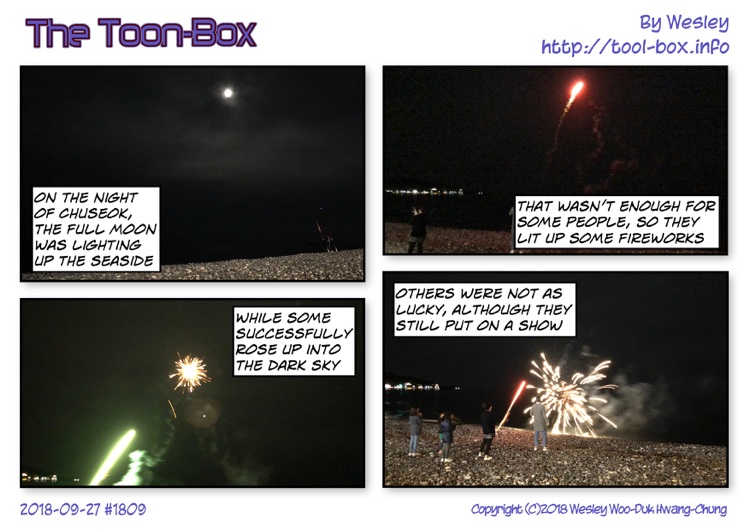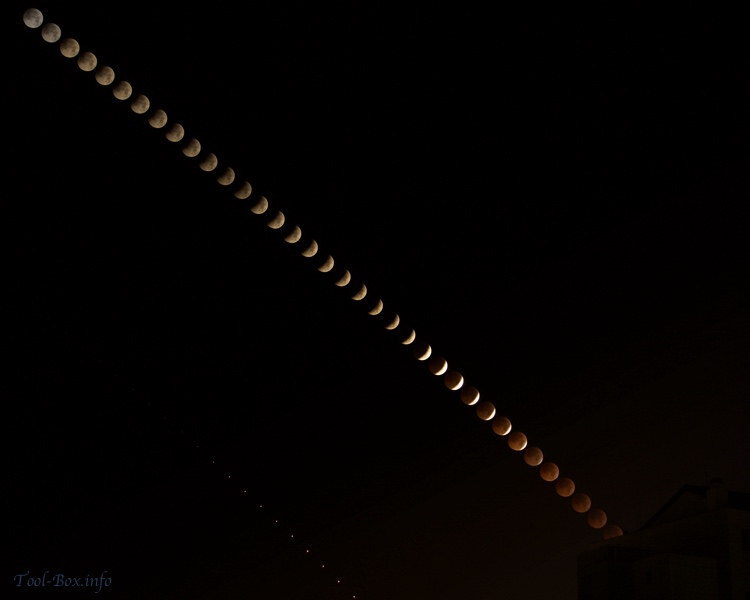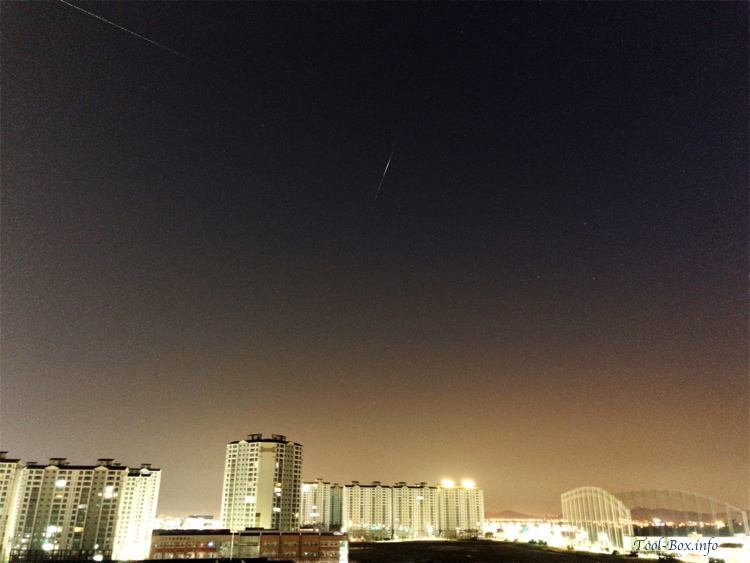Entries tagged as satellite
astronomy camera Moon Sanyo VPC-C4 Minolta Dimage X20 binoculars Chuseok telescope eclipse Kodak Z1085 IS star Sun iPhone 4 Canon SX50 HS planet Saturn constellation Lyra lightning ISS Jupiter iPhone 5S Canon EOS 450D Venus C/2013 R1 Lovejoy comet CHDK smog airplane Boötes Andromeda galaxy flare Iridium Alhena Orion Mars Celine Chung Hayun Chung HT-Mini v2 toy MetOp-A Ursa Minor Leo Minor Ursa Major A1533 slow motion A1530 LTE iOS iPhone 4S sound electric fan LED light trail M&M's A1524 iPhone 6 Plus OIS Cortex Camera Focus Pixels A1522 A1549 A1586 barometer belt case iOS 8 iPad iPad mini iPhone 3GS iPhone 5 iPhone 5C iPhone 6 KT LGU+ China Korea lunar calendar Bushnell 8x40 fog Naju iPhone 7 Plus Bitgaram City Sony A5000 beach firework Ulsan Nikon CoolPix P1000 almond nuts walnut duck river Sung-Eun Kim Yeongsan cafeteria ice KPX persimmon Korean dress rice cake beverage chocolate Celestron NexStar 6SE Snapzoom dwarf planet Pluto asteroid Josephina Neptune Triton Jeonnam Science Festival Messier 11 Messier 2 adapter iPhone 6S Plus artificial star collimation focal reducer 3DMark Geekbench Octane SunSpider Touch ID battery PeaceKeeper charger box iPhone 6+ iPhone 7 Raynox DCR-1540PRO teleconverter Vivitar 2.0X iOptron SkyTracker Nikon D3300 Samyang Polar 800mm Toast TP-2 Bode's Galaxy Cigar Galaxy Ceres Heze Vesta Zeta Virginis iPhone X Goheung Naro Space Center travel Bolt EV car electric SpaceX Dragon Jeonju space station Tiangong electric vehicle expressway parking lot service area Boeing Daejeon international spacecraft C/2014 Q2 Lovejoy nebula Taurus road shade cat assembly kit iPhone 11 Pro Singapore cup Starbucks Sight Knight visor iPhone 13 Pro Gunsan Milky Way Uranus AT&T SK Telecom fingerprint sensor M7 pedometer Kraken performance accelerometer compass gyroscope Han-gang Seoul passcode Kiwi Fotos KF-8012N Hiroshima iPhone 16 Pro Japan iPhone XS Christmas tree decoration balls lights sled snow screwdriver table cookie milk Oreo Homeplus pizza chocolate chip cookies couch FaceTime New Year's Day Skype tteokguk computer swing Toys R Us trampoline Mega Kids Box Megabox movie theatre Wesley Woo-Duk Hwang-Chung tortilla wrap toothbrush salad Disney Frozen remote controlled helicopter repair replacement Syma S107G Danish butter cookies animation Larva shopping cart meteor shower Perseids Scorpius M8 Reachability screen protector VoLTE Apple Pay credit card debit card NFC RFID Manually Canada Hong Kong T-Mobile USA Verizon Apple Store Fukuoka Fukuoka Airport Incheon International Airport subway leather case Vega LTE-A KEPCO construction lake park BHC chicken blizzard Lotteria snow angel Cajun Fries Mom's Touch Thigh Burger water contamination food truck Chappie Gwangju Gwangju Songjeong Station movie Burger King restaurant farm garden coffee shop sidewalk Gochunaengi pork cutlet sushi electricity emergency news summer television winter book Education Center Yu-Kyung Ha 123D Design 3D printing Autodesk coin Makibox Bulacan Philippines school volunteering trash relocation cabinet EMS K-EMS New EMS desk paint monument cake Christmas bus broiled eels eel Mac mini server library convenience store KTX-Sancheon meal box VoIP screen Screen Glue Ferris wheel game Goat Simulator COEX fine dust building Pepero Pepero Day Anex ANH2-065 screw T-adapter 2015 TB145 NASA Bode’s Galaxy Sombrero Galaxy
Today’s “The Toon-Box”
Posted by Wesley on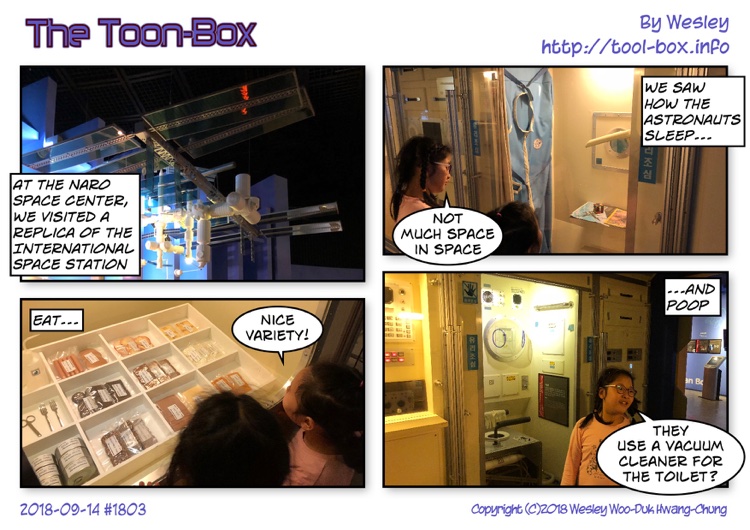
Defined tags for this entry: Celine Chung, Goheung, Hayun Chung, ISS, Naro Space Center, satellite, travel
Century's longest total lunar eclipse and Mars
Posted by Wesley on36-photo composite of the July 2018 total lunar eclipse and the trailing Mars (click for higher resolution)
Those living in Korea was able to see the second total lunar eclipse of the year, following the one in January 31. I had multiple reasons to watch this eclipse. There wasn’t going to be another total lunar eclipse visible in Korea for nearly three years (next one is on May 26, 2021). Also, Mars was just past the opposition, shining bright next to the Moon and forming an interesting celestial pair. Finally, the eclipse was billed as the longest in the century, including more than 103 minutes of totality.
Weather cooperated well, and I was able to both observe and record the progress without a hitch. The result is the composite photo above. It was the first time my newly acquired Sony SEL55210 lens was put to use for astrophotography and it performed adequately.
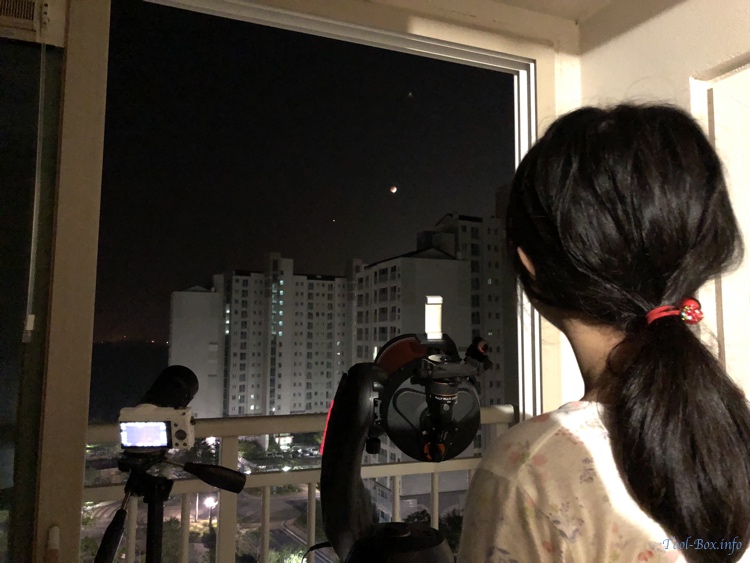
Celine witnesses her first lunar eclipse after waking up early
One minor disappointment was that the Moon was to set below the horizon during the middle of the totality. So I focused on watching it comfortably in the house with my daughter instead of trying to see through every moment. In fact, it was first such eclipse visible through the southerly window since 2011, enabling Celine to see the phenomenon for the first time. She was impressed with how the full Moon progressively got dimmer from the left corner, eventually becoming red from the Earth’s shadow. Next time, I hope I can show her the comeback part.
Device: Sony A5000 + SEL55210 (E 55–210 mm F4.5–6.3 OSS)
Settings: 55mm - ISO 100 - 1/500s to 5s - f/4.5
Filters: None
Time: 2018-07-28 01:12-04:40 KST
Location: Naju, Korea
Defined tags for this entry: astronomy, Bitgaram City, camera, Celine Chung, Moon, Naju, satellite, Sony A5000
A more successful tracking of ISS
Posted by Wesley on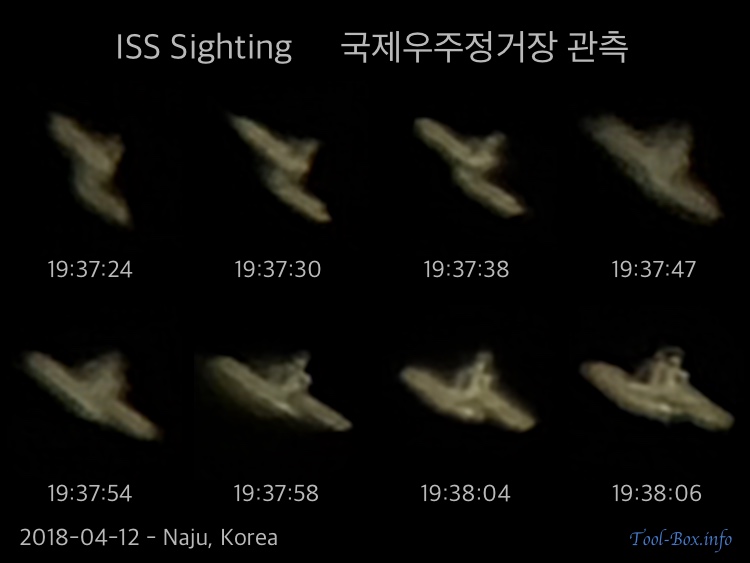
ISS as seen from Naju in April 12, 2018
After several days of clear skies, clouds have been rolling in for the past two days. Amazingly, they did thin out for a few hours in the evening, enabling me to see the ISS for two consecutive days under good conditions. Tracked observation on April 11 failed due to low battery on the telescope, but I was better prepared on April 12 and made a successful tracking.
The International Space Station was 546km away from me at the closest approach at 19:38:03 (408km altitude, -3.6 mag brightness), so the second photo from the bottom right is representative of this. It is coincidentally the clearest photo I got. You can identify many of the modules - starting from the Zvezda module on the top and moving down, you can see the Zarya module in the center with two radiator panels side by side. On the bottom, you can see the cluster of Columbus-Harmony-Kibo modules in the center, with large solar panels on each end. The bright spot is likely where the SpaceX Dragon spacecraft from the CRS-14 mission is currently docked at.
As I have captured several hundreds of frames, it was sufficient enough to arrange them into this 34-second video clip. I have hosted the file on the website, and it should be watchable on a modern browser.
Telescope: Celestron NexStar 6SE + X-Cel LX 9mm eyepiece
Device: iPhone X (afocal)
Settings: 28mm - ISO 400 - 1/1500s - f/1.8
Filters: None
Date/Time: 2018-04-12 19:37-19:38 KST
Location: Naju, Korea
Photos processed with PIPP 2.5.6 and RegiStax 6.1.0.8
Last look of Tiangong-1 with Iridium 80
Posted by Wesley onTiangong-1, the first Chinese space station, is set to fall back to Earth around April 2. Its orbit had been slowly decaying since its service was ended in 2016. I found out that it would be visible for one last time in the sky this morning, so me and my daughter Celine decided to witness its streak. I set up my iPhone X on a tripod and placed it on the window facing north. Then I launched NightCap Camera app in satellite capturing mode.
Shortly after 5:30AM, Tiangong-1 made its bright (-0.6 magnitude, 181km altitude) appearance from the west, streaking towards east and quickly dimming. Just as it disappeared from our eyesight, another bright flash appeared to the east of Polaris and then quickly disappeared. From my experience I knew that was an Iridium flare. CalSky website verified it to be Iridium 80, showing up at 5:30:36AM with a magnitude of -2.0. We were very lucky to see the two together - since the space station will disappear in a couple of days it was truly a once-in-a-lifetime experience.
On the photo, you can see, starting from the top left and looking towards bottom right, the Tiangong-1, Polaris, Iridium 80, and the Cassiopeia constellation. Click on the image to see it in full size.
Device: iPhone X
Settings: 28mm - ISO 2112 - 61s - f/1.8
Filters: None
Date/Time: 2018-03-31 05:30:01 KST
Location: Naju, Korea
